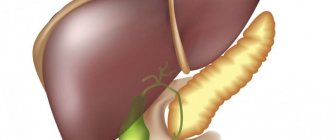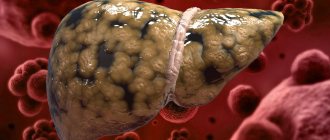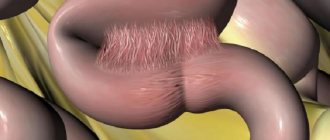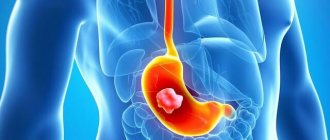Gastric atony is a pathology that is characterized by a decrease in the tone of muscle tissue in the walls of the digestive organ. As a result of this process, the stomach stretches and undigested food accumulates in the weakened part of the organ. The deterioration of contractile function significantly affects the patient's condition. The main symptom indicating the development of the disease is constipation.
- Etiology
- Symptoms
- Diagnostics
- Treatment
- Complications
- Prevention
Quite often, doctors diagnose pathology in asthenic and exhausted patients.
Therapy of the pathology is aimed at restoring the motor function of the stomach.
What is gastric atony
Gastric atony is a sustained relaxation of the muscles of this organ, loss of tone in its walls. At the moment when a person begins to consume food, the stomach relaxes, but when the chewed mass enters it, the walls contract, and the food is, as it were, covered on all sides by the muscles. This function is called peristalsis; if under the influence of any reasons it is inhibited, then food stagnates and is ineffectively digested. It is easy to understand that such a phenomenon causes discomfort and problems in the operation of the system as a whole.
Specialist Note: There is a disease called hypotension, and it has similar symptoms and development mechanisms. Its essence lies in a decrease in the activity of peristalsis, which complicates the processes of digestion of food masses. Atony, in turn, is a relaxation of muscles of a stable nature, that is, it is a more advanced and complex problem in gastroenterology.
Gastric atony
Causes
Disruption of the normal innervation of the walls of an organ can be provoked by various factors, and first of all, experts consider the possibility of provoking this condition by lesions of the nervous system. In turn, a heart attack, severe pneumonia or peritonitis can have a negative impact on the nervous system in this context. It can be very difficult to establish the cause of a decrease in the tone of the gastric muscles, since the primary source can even be any infectious disease (Lyme disease, botulism, legionellosis, typhoid fever and others).
Also among the possible causes of the development of atony, doctors identify:
- exhaustion of the body against the background of painful thinness (for example, with anorexia);
- congenital pathologies in the form of organ elongation or prolapse;
- disturbances in the processing of food due to the consumption of coarse, large pieces or the entry of toxic substances into the digestive system;
- endocrine diseases can affect the level of hormones that are responsible for regulating the functioning of the digestive system;
- thrombosis of gastric vessels;
- mechanical damage to the stomach or spinal cord, both in everyday life and during surgery;
- severe chronic stress conditions;
- excessive overeating, leading to stretching of the walls.
Delayed gastric emptying (gastroparesis) causes
Gastroporesis is a disorder of gastric motility, in which its dysfunction develops. With the help of its muscles, the stomach crushes and pushes food into the small intestine. With gastroparesis, muscle contractions slow down, which leads to retention of its contents in the lumen.
The causes of the pathology can be diabetes mellitus, previous surgical interventions on the stomach, medications (narcotic painkillers, antidepressants), stress and neurology. If gastric motility is impaired, the patient experiences excruciating cutting pain in the abdomen and debilitating nausea.
Poor gastric emptying can occur for the following reasons:
- the outlet of the stomach (pylorus) may be blocked by an ulcer, tumor, or something swallowed and not digested;
- The pyloric sphincter at the exit of the stomach does not open sufficiently or at the right time to allow food to pass through it. This sphincter is controlled by neurological reflexes that ensure that only very small particles leave the stomach and that not too much acid or sugar comes out of the stomach, which could irritate or injure the small intestine. These reflexes depend on nerves that are sometimes damaged;
- The peristaltic, three-minute contractions of the lower stomach may become out of sync and stop moving stomach contents towards the pyloric sphincter: usually this also has a neurological basis, the most common cause of which is long-term diabetes mellitus, but in many patients the reason for the delay in gastric emptying is unknown, so they are diagnosed as idiopathic ( that is, with an unknown cause) gastroparesis.
Constant stagnation of food in the stomach cavity can create an environment that is favorable for the development of bacterial infections such as gastritis.
Abnormal motility or sensitivity in any part of the gastrointestinal tract can cause characteristic symptoms such as food retention, pain, heartburn, nausea and vomiting. To determine how adequate the motility of each part of the gastrointestinal tract is, certain studies are performed, based on the results of which general practitioners, gastroenterologists or surgeons make decisions regarding the best treatment option.
Consequences of food remaining in the stomach for a long time
Due to the long stay of food in the stomach, the food mass can harden, and a so-called bezoar, which is a lump of dense mass, can form in the stomach cavity.
Further, such a formation can move through the gastrointestinal tract and provoke the closure of intestinal loops. This condition is called intestinal obstruction, which is also fraught with dangerous complications, including peritonitis. Constant stagnation of food in the stomach cavity is fraught with the creation of an environment that is favorable for the development of bacterial infection. Under such circumstances, the patient may develop an inflammatory process - gastritis.
https://youtu.be/MVxnkrl6lIk
Symptoms
There are two main forms of gastric atony based on the complexity of the situation and the degree of innervation disturbance - mild (which is called hypotension) and severe form (obstruction). Depending on the specific form, the patient may experience different symptoms.
Light form
In mild cases, the main complaint of patients is a feeling of heaviness after meals and constant constipation. Emptying occurs rarely, once every few days, while the volume of excreted feces is insignificant, they are dense and dry in consistency. An important sign is the absence of the normal feeling of relief after bowel movements.
Severe form
A severe form of the disease requires urgent treatment at the hospital. In its acute form, it manifests itself with the following symptoms:
- the feeling of fullness in the stomach does not go away over time;
- there is a feeling of fullness and severe heaviness;
- the pain is dull but intense;
- hiccups, belching;
- vomiting in copious amounts.
With chronic severe obstruction, the patient experiences rapid satiety, a sharp loss of appetite even at the beginning of eating, and a feeling of nausea. An obvious deterioration in well-being usually appears as a result of eating fatty foods or after drinking large amounts of water or drinks. The pain is dull, bursting in nature.
Symptoms
Among the main symptoms of gastric atony are:
- burping,
- increased acidity of gastric juice,
- pale skin,
- increase in stomach size,
- dull pain in the abdomen,
- feeling of heaviness
- nausea, vomiting,
- increased blood pressure,
- lack of appetite and feeling of fullness,
- specific odor from the mouth.
In the absence of timely treatment, symptoms gradually increase and the disease progresses. Signs of a severe form of atony manifest themselves in acute or chronic gastric obstruction. In this case, undigested pieces of food are visible in the patient’s vomit.
Poor circulation provokes gastric rupture, and therefore you should not delay treatment of atony. Self-medication only aggravates the patient’s condition and leads to gastritis, as well as other serious complications.
Diagnostic methods
To make a diagnosis, in addition to collecting patient complaints, a number of hardware studies are required. The endoscopic method is used quite often, but sometimes when the tube gets into the stomach, immediate emptying occurs through vomiting. During the procedure, you can observe an expanded organ cavity, which is filled with a large amount of content. Peristalsis is extremely weakened, but mucous folds are preserved.
An x-ray procedure using contrast is required. With atony, the contrast agent immediately settles in the lower part of the organ; the stomach in the picture has an elongated shape with a clearly lowered bottom.
Dietary food for patients
Persons who have been diagnosed with food stasis in the stomach are prescribed a therapeutic diet (table No. 2). According to this nutritional plan, foods and dishes that take a long time to be digested in the gastrointestinal tract and irritate the mucous membrane of the digestive tract are excluded from the patient’s diet:
okroshka, soups made from milk and legumes;
- pastries, puff pastry products, fresh bread;
- fatty meat and fish, smoked meats, pickles, canned food;
- hard boiled eggs;
- barley and pearl barley, corn, millet;
- mushrooms;
- cucumbers, bell peppers, garlic, rutabaga, radishes, onions and any raw vegetables;
- spicy or too fatty sauces;
- cream products, chocolate, ice cream;
- figs, dates, berries with rough skin or grains;
- lard, animal fats;
- kvass, grape juice.
Patients are advised to eat pureed or liquid foods rich in vitamins and fiber. A proper diet includes 7-9 meals a day.
Compliance with all medical recommendations allows you to achieve long-term remission. To prevent relapses, patients are advised to regularly undergo courses of sanatorium-resort treatment in regions with a mountainous or sea climate, drink mineral waters and perform physical exercises that strengthen the abdominal wall.
Treatment
As already mentioned, the disease is complex, so its treatment requires a serious, comprehensive approach. Treatment is not limited to taking pills alone.
Diet
Food should be consumed in small portions up to 10 times a day. Preference is given to liquid food, which is easily digestible. Any dishes that can provoke irritation of the mucous membranes are completely excluded from the diet (we are talking about smoked meats, fatty, spicy, too cold or hot foods). Nutrition in solid and liquid form is separated.
Mandatory foods to eat are honey, prunes, yogurt and black bread - they stimulate the stomach. Let's look at an example of a menu for one day, designed for 6 meals:
- boiled egg, oatmeal, a little cottage cheese and tea;
- fruit compote with a slice of black bread;
- chicken meatball soup and a slice of bread;
- baked fish with wheat porridge, rosehip decoction;
- milk soup with the addition of crackers;
- a glass of kefir or yogurt before bed.
Recommended products for stomach atony in the photo
Oatmeal normalizes digestion
Rosehip decoction has a beneficial effect on the entire gastrointestinal tract
Eating baked fish stimulates gastric activity
Kefir starts the digestive process
Boiled eggs have a beneficial effect on the stomach
Drug therapy
For atony, the prescription of medications is also a mandatory element of therapy. The list of medications usually includes the following drugs:
- for general strengthening of the body, vitamins;
- to improve gastric motility;
- to stimulate cell recovery;
- antiemetics;
- calcium and potassium.
In some cases, strychnine (it restores peristalsis and improves the secretion of gastric juice) and arsenic preparations can be used. Proserine is used to facilitate the transmission of nerve impulses. The product helps restore the conductivity of nerves and muscles, thereby increasing the muscle tone of the stomach and stimulating the activity of the glands.
Doctor's note: In medical practice, the use of human insulin in the treatment of this disease is common. The injection is given half an hour before meals, the specific dose is determined by the attending physician (from 5 to 20 units).
The need for a bandage
Waist bandage
The problem of atony is directly related to weakening of muscle structures, therefore, in addition to physical therapy, the patient in severe stages must wear a special bandage. It is worn in a lying position, and very often wearing it almost immediately eliminates all the unpleasant sensations associated with the disease. If the belly is saggy and large, this method is strictly necessary.
Traditional methods of treatment
Chamomile decoction has a beneficial effect on the stomach
Alternative medicine is used as an additional method, the use of which requires mandatory agreement with the attending physician. The main direction of influence of folk recipes is to enhance gastric peristalsis to restore its functions. Herbal decoctions of yarrow, oregano, large plantain, dandelion root, coltsfoot, chamomile flowers or rose hips, ginseng root can help solve this problem. Preparing the infusion involves performing the following steps:
- dried grass or roots in crushed form are used in the amount of one tablespoon;
- the main ingredient is poured with a glass of boiling water and simmered over low heat for several minutes;
- after this, the broth is cooled under the lid;
- After cooling, the product is filtered and it is ready for use.
Strengthening the nervous system and the body as a whole
Common methods include physical therapy, massage sessions, and taking vitamin complexes. Exercises help restore muscle tone and stimulate blood flow to the abdominal cavity:
- exercise bicycle lying on your back;
- in the same position, the legs are bent at the knees and pulled to the stomach as much as possible, covering them with the arms;
- the next task is to remain on your back, throw your legs behind your head and return to the starting position (you can support the lumbar region with your hands);
- bending to the side at a slow pace;
- imitation of chopping wood - as you exhale, you need to lean forward, and as you inhale, return to the starting position;
- starting position – kneeling, leaning on outstretched arms. In this position, you need to alternately stretch your legs back.
The lesson is held daily, each task is recommended to be repeated ten times. Rowing and skiing also help strengthen motor skills.
A set of exercises to stimulate the stomach
Nutrition for atony
Diet plays an important role in the treatment of the disease. You need to eat in small portions: often and in small portions, so the food is better absorbed and overeating does not occur. You should also limit the amount of liquid.
For atony of the stomach and intestines, the diet should include:
- carrot,
- bran bread,
- kefir and yogurt,
- beets,
- oranges,
- buckwheat porridge,
- fruit and vegetable juices,
- lean poultry and fish.
The diet involves complete abstinence from foods:
- whole milk,
- fried and smoked,
- cakes and pastries,
- chocolate and coffee,
- canned food
In addition, astringent fruits, mushrooms, garlic, legumes and radishes should be consumed in minimal quantities.
Associated diseases and complications
When diagnosing the problem, the main difficulty is that atony is often accompanied by a number of other disorders (nervous dyspepsia or gastroptosis), and it is necessary to clearly separate the symptoms and manifestations of diseases from each other. Stomach atony is dangerous because the symptoms quickly increase, and complications do not keep you waiting. Constant stagnation of food leads to the occurrence of inflammatory processes in any organs of the digestive system and biliary tract. The most common complication is gastritis. If the patient is not helped in a timely manner, the stomach may rupture due to a disruption in the blood supply to the walls.
How does the stomach work?
The stomach is a complex mechanism that tirelessly works to break down and absorb food in humans. A failure in this system can result in diseases such as acute and chronic gastritis, gastric or duodenal ulcers. The stomach is a continuation of the esophagus and one of the most important organs of the digestive system. It is located under the diaphragm (in the upper part of the abdominal cavity). It is separated from the esophagus and duodenum by the sphincter (circular muscle).
The stomach is a complex mechanism that tirelessly works to break down and absorb food in humans.
The stomach is responsible for the breakdown of organic substances and their promotion to the next section of the gastrointestinal tract. The volume of an empty stomach of an adult usually does not exceed 500 ml; after eating it increases several times and is about 4 liters. The area of the gastric mucosa is from 0.1 to 0.2 m2. The acidity of an empty, healthy stomach is 1.5 – 2.0 pH. For comparison, a solution of inorganic acids with this pH value can successfully dissolve polymers. The glands produce from 2 to 2.5 liters of gastric juice per day.
When food enters the lower esophagus, the inlet sphincter opens. During normal functioning of the digestive system, food entering the stomach is mixed with gastric juice and begins to be digested. At this moment, acidity levels change.
Retention of food in the stomach can be explained by several factors, including stretching of the gastric walls, changes in pH, and the physical and chemical characteristics of food. The lower sphincter opens after a signal from the autonomic nervous system, which sends impulses from the brain to the muscle tissue of the stomach. After this, the substance processed in the stomach enters the duodenum.
Gastric motility disorder
Slowing the evacuation of food from the stomach is called gastroparesis. Impaired gastric emptying may develop due to complications that arise during long-term diabetes mellitus. Surgeries such as vitrectomy or partial gastrectomy impair the evacuation of solid food from the stomach due to dysfunction of the antral and pyloric (pyloric) parts of the stomach or the absence of these parts.
Other causes of gastric motility disorders include: the effects of medications (opiates, antidepressants, anticholinergic drugs, levodopa), metabolic disorders (ketoacidosis, hypothyroidism, electrolyte imbalance), mental illness (anorexia nervosa), pathology of the central nervous system (brain tumor) , infection (acute viral gastroenteritis) and idiopathic factors.
In each of these cases, there are complex pathophysiological mechanisms involving many components, including disorders of nervous and hormonal regulation, electrical rhythm and gastric smooth muscle function.











